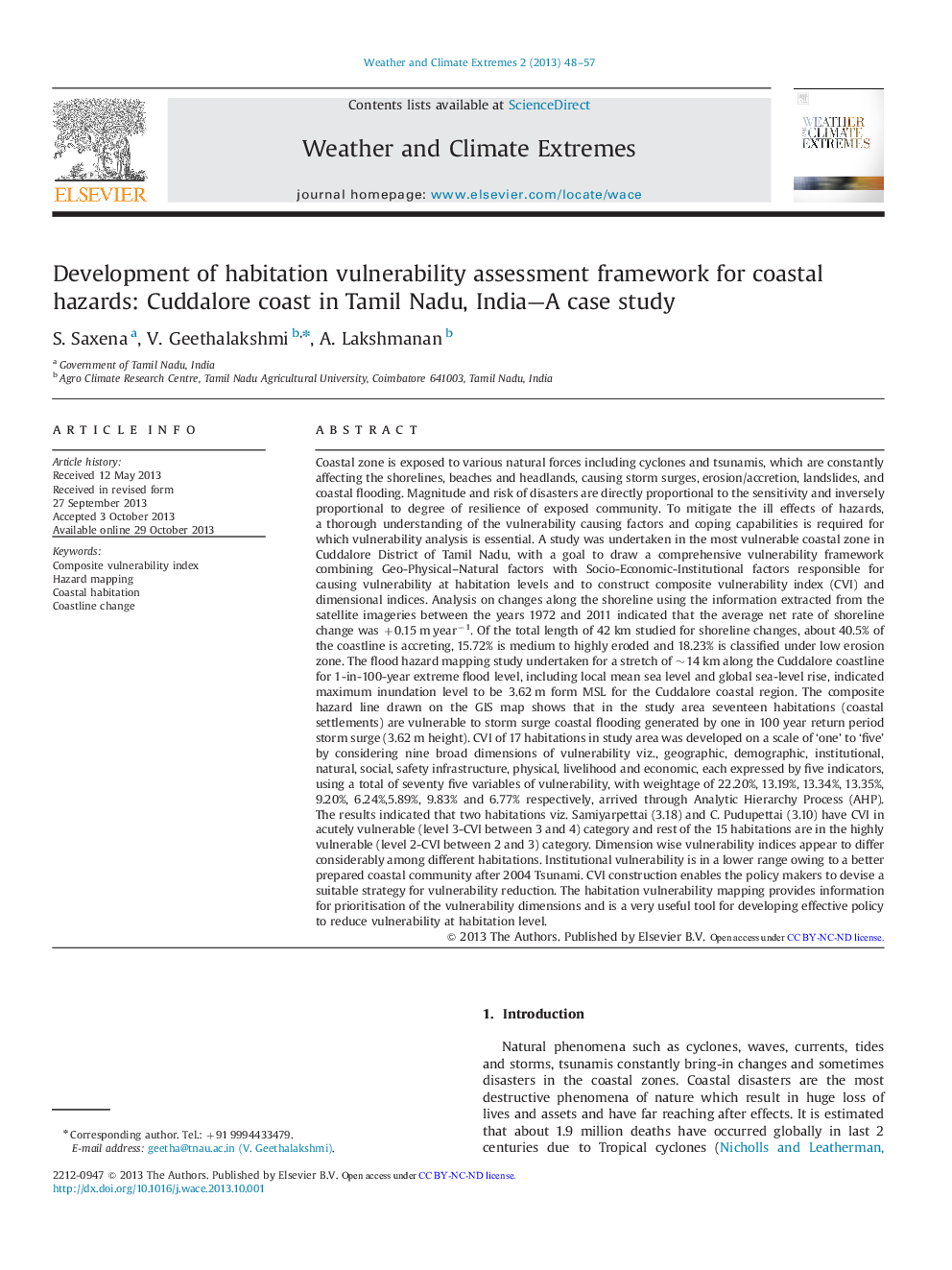| کد مقاله | کد نشریه | سال انتشار | مقاله انگلیسی | نسخه تمام متن |
|---|---|---|---|---|
| 1066769 | 1485954 | 2013 | 10 صفحه PDF | دانلود رایگان |

• Traditional wisdom to forecast natural hazards improve communitys' emergency response.
• Disaster preparedness is a continuous process as vulnerability varies temporally.
• Protecting coastal ecology and identification of vulnerable areas reduces risk exposure.
• Diversification of sources of livelihood improves the community resilience.
Coastal zone is exposed to various natural forces including cyclones and tsunamis, which are constantly affecting the shorelines, beaches and headlands, causing storm surges, erosion/accretion, landslides, and coastal flooding. Magnitude and risk of disasters are directly proportional to the sensitivity and inversely proportional to degree of resilience of exposed community. To mitigate the ill effects of hazards, a thorough understanding of the vulnerability causing factors and coping capabilities is required for which vulnerability analysis is essential. A study was undertaken in the most vulnerable coastal zone in Cuddalore District of Tamil Nadu, with a goal to draw a comprehensive vulnerability framework combining Geo-Physical–Natural factors with Socio-Economic-Institutional factors responsible for causing vulnerability at habitation levels and to construct composite vulnerability index (CVI) and dimensional indices. Analysis on changes along the shoreline using the information extracted from the satellite imageries between the years 1972 and 2011 indicated that the average net rate of shoreline change was +0.15 m year−1. Of the total length of 42 km studied for shoreline changes, about 40.5% of the coastline is accreting, 15.72% is medium to highly eroded and 18.23% is classified under low erosion zone. The flood hazard mapping study undertaken for a stretch of ~14 km along the Cuddalore coastline for 1-in-100-year extreme flood level, including local mean sea level and global sea-level rise, indicated maximum inundation level to be 3.62 m form MSL for the Cuddalore coastal region. The composite hazard line drawn on the GIS map shows that in the study area seventeen habitations (coastal settlements) are vulnerable to storm surge coastal flooding generated by one in 100 year return period storm surge (3.62 m height). CVI of 17 habitations in study area was developed on a scale of ‘one’ to ‘five’ by considering nine broad dimensions of vulnerability viz., geographic, demographic, institutional, natural, social, safety infrastructure, physical, livelihood and economic, each expressed by five indicators, using a total of seventy five variables of vulnerability, with weightage of 22.20%, 13.19%, 13.34%, 13.35%, 9.20%, 6.24%,5.89%, 9.83% and 6.77% respectively, arrived through Analytic Hierarchy Process (AHP). The results indicated that two habitations viz. Samiyarpettai (3.18) and C. Pudupettai (3.10) have CVI in acutely vulnerable (level 3-CVI between 3 and 4) category and rest of the 15 habitations are in the highly vulnerable (level 2-CVI between 2 and 3) category. Dimension wise vulnerability indices appear to differ considerably among different habitations. Institutional vulnerability is in a lower range owing to a better prepared coastal community after 2004 Tsunami. CVI construction enables the policy makers to devise a suitable strategy for vulnerability reduction. The habitation vulnerability mapping provides information for prioritisation of the vulnerability dimensions and is a very useful tool for developing effective policy to reduce vulnerability at habitation level.
Journal: Weather and Climate Extremes - Volume 2, December 2013, Pages 48–57